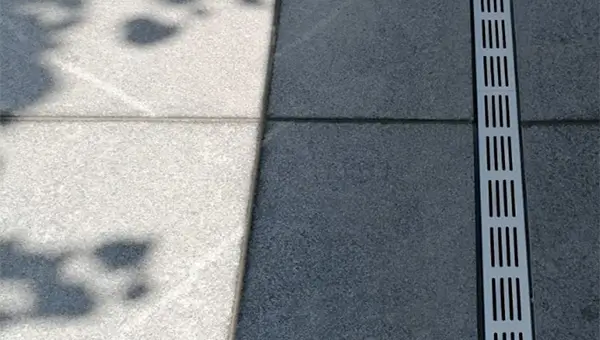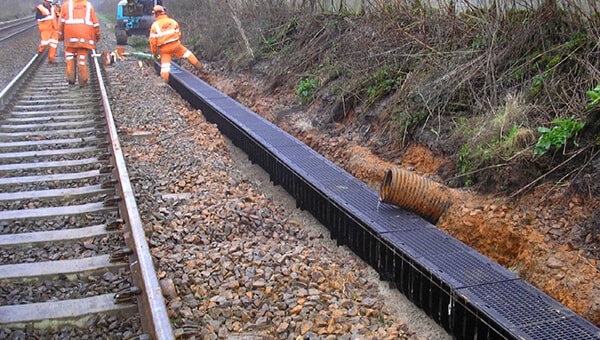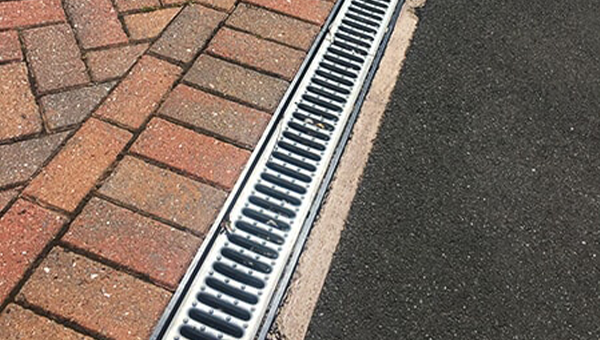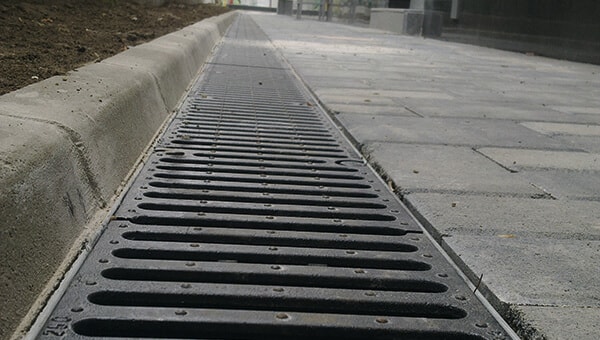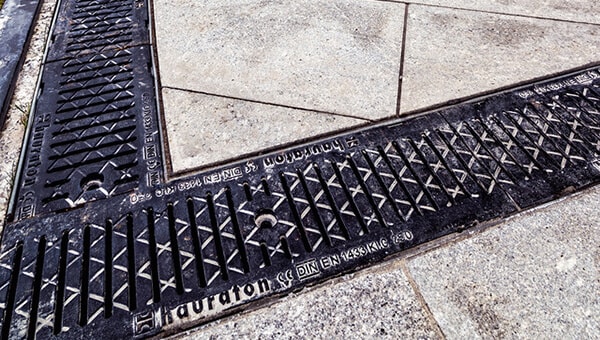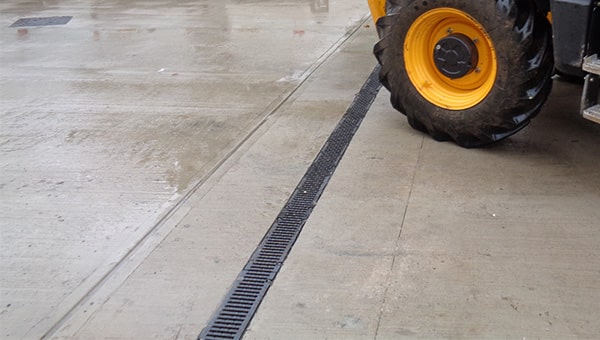
Channel drains, with their practicality, efficiency, and affordability, emerge as the go-to solution for handling surface water runoff from outdoor areas like driveways and patios. However, the market teems with a diverse array of linear channel drainage options, a spectrum that might leave you pondering the best fit for your project.
When it comes to choosing the right channel drain, though, the best place to start is by asking yourself the following:
- What are the loading requirements – what type of traffic will it need to withstand?
- What is the application - where is the channel drain being installed?
To help you answer them, we’ll take a closer look at each one individually while also explaining how the answers can influence each other.
Channel Drain Loading Requirements
The loading requirement of a channel drain refers to the amount of weight it can safely support. This is, arguably, the most important factor to consider for both durability and safety reasons; you don't want to install a channel drain that will collapse under the weight of a vehicle or pedestrian.
Fortunately, channel drains are classified by their loading requirements, with A15 being the lightest and F900 being the heaviest, making it a little easier to find the right one. The trick is in knowing which requirement best suits your needs. To help with this, check out the table below, which shows a brief description of the different loading requirements and their typical applications:
| Load Class | Max Weight Load (Tonnes) | Typical Applications | |
|---|---|---|---|
| A15 Load Class | 1.5 | Lightly trafficked pedestrian-only areas, patios, and gardens. | |
| B125 Load Class | 12.5 | Heavily trafficked pedestrian areas, such as public footpaths, and lightly trafficked vehicle areas, such as areas with slow-moving traffic and domestic driveways. | |
| C230 Load Class | 25 | Commercial areas, such as supermarkets and retail parks, small private car parks, and lightly trafficked roads. | |
| D400 Load Class | 40 | Heavily trafficked vehicle areas, such as carriageways of main roads, highways, and public car parks. | |
| E600 Load Class | 60 | High wheel load areas, such as forklift loading bays, cargo handling yards, and airfield pavements. | |
| F900 Load Class | 90 | Heavy-duty Industrial areas, such as docks and airport taxiways/runways. |
So, how do you know which loading requirement is right for your needs? Well, it is important to consider the following when trying to answer that question:
- What type of traffic will be using the channel drain? - If it will be used by pedestrians and bicycles, then an A15 drain will be sufficient. However, if it will be used by vehicles, then you'll need a channel drain that can handle at least B125 loading.
- What is the size and weight of the vehicles that will drive over or park on top of the channel drain? - If there is even the slightest possibility that you have heavy vehicles present, then you'll want a channel drain with a higher loading capacity.
- What is the intended location of the channel drain? - B125 and C250 are suitable for light and medium vehicle traffic areas, but if the channel drain is to be located in a high-traffic area, then you'll need a drain with a higher loading capacity.
Here are a few tips to keep in mind when considering which channel drain loading requirement will best suit your project:
- Over-engineering is always better than under-engineering. - If you're not sure which loading requirement to choose, it's always best to choose a higher one.
- Check with your local building codes. - Some codes may require you to use a channel drain with a specific loading requirement.
- Get professional advice. - If you're still not sure which loading requirement to choose, it's always best to consult with a professional engineer.
By following the above tips and advice, you should be able to choose the right channel drain loading requirements for your needs and ensure that your drain is safe and reliable. If you are still unsure, this next section might help as we match up the loading requirements with the most common applications.
Channel Drain Applications
Linear channel drainage is a popular choice for a variety of applications, including:
- Patio Drainage - channel drainage can be used in patio areas to collect rainwater and prevent it from flooding the area.
- Footpath Drainage - channel drainage can also be used in paths to collect rainwater and prevent it from causing slips and falls.
- Driveway Drainage - channel drainage can also be used in driveways to prevent water from damaging the pavement.
- Car Park Drainage - channel drainage is often used in car parks to collect rainwater and prevent it from pooling.
But how do you know which channel drain is right for each type of application? The easiest way to answer this is to first decide if you need channel drainage for a Domestic (light-duty), Commercial (medium-duty), Industrial (heavy-duty), or Specialised application.
Domestic Channel Drain Applications
The first type of loading application for linear channel drainage is Domestic or light-duty. These are channel drainage systems that are commonly used in residential applications where foot traffic or occasional light vehicular traffic is expected. This means that the system is designed to withstand pedestrian-only traffic or light vehicular traffic, such as bicycles, mopeds, motorbikes, and cars, in areas such as backyards, pedestrian walkways, and driveways. Light-duty systems are generally less expensive, but their use needs careful consideration. A light-duty channel drain will be recommended for use in most driveways. However, if you frequently park a larger vehicle, such as a van or motorhome, on your driveway, a light-duty channel drain may not have suitable loadbearing qualities. This is why it is important to match the application with the most suitable loading requirement. Here is a list of typical light-duty channel drain applications, along with their recommended loading requirements:
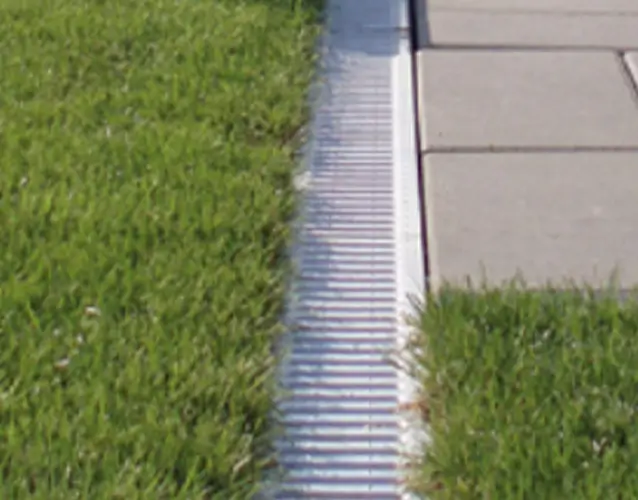
Pedestrian/Landscape Drainage Loading
Landscape drainage loading is another common linear channel drainage application which involves directing rainwater from landscape areas, such as gardens, parks, and sports fields. It's a crucial part of garden maintenance as it prevents soil erosion and potential moisture damage to the foundations of surrounding buildings.
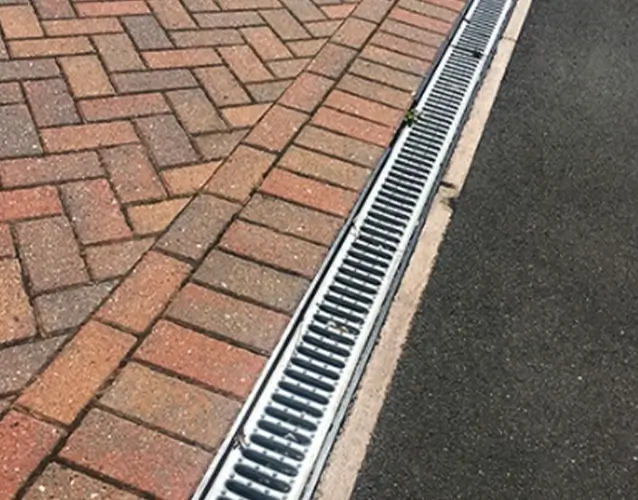
Driveway Drainage Loading
One of the most popular loading applications of linear channel drainage is for domestic driveway use. Domestic driveway use typically refers to drainage systems that cater to pedestrian traffic and light vehicular use in residential areas, such as public footpaths and, unsurprisingly, driveways.
The loading requirements of light-duty channel drain applications typically range between A15 to B125, depending on the specific application. To ensure the proper drainage system is selected for your needs, however, you must evaluate the potential weight loads and the frequency of use of the area you want to install a linear channel drainage system. For any light-duty applications, the general rule of thumb should be:
- Light pedestrian/foot traffic only (maximum 1.5 tonnes and under) = A15 class channel drain will be suitable. This includes:
- Gardens and lawns
- Patios and decking
- Pedestrian areas
- Cycleways
- Heavy pedestrian and/or light vehicle traffic (maximum 12.5 tonnes and under) = B125 class channel drain is needed. This includes:
- Frequently trafficked driveways
- Pedestrian areas in small private car parks
- Public footpaths and cycleways
For more about channel drainage use in driveway applications, check out our separate article, “Most common drainage problems on your driveway”.
If you think there is even the slightest chance that a vehicle may need to drive over or park on top of the area where the channel drain will be installed at any time, now or in the future, it is probably worth considering a B125 class channel drain just to be safe. Equally, while B125 will be more than suitable for the vast majority of light-duty applications, if you know that heavier vehicles will need access to the area on a regular basis, such as delivery vehicles and garbage trucks, then upgrading to a C250 or D400 class channel drain might be required to prevent the channel drain from becoming damaged.
Commercial Channel Drain Applications
The second type of loading application for linear channel drainage is Commercial or medium-duty. This means that the system is designed to withstand heavier vehicular traffic, such as cars and trucks, as can be expected in commercial or transportation areas. These systems are generally more expensive than light-duty systems but are necessary for areas such as supermarkets, car parks, main roads, and motorways.
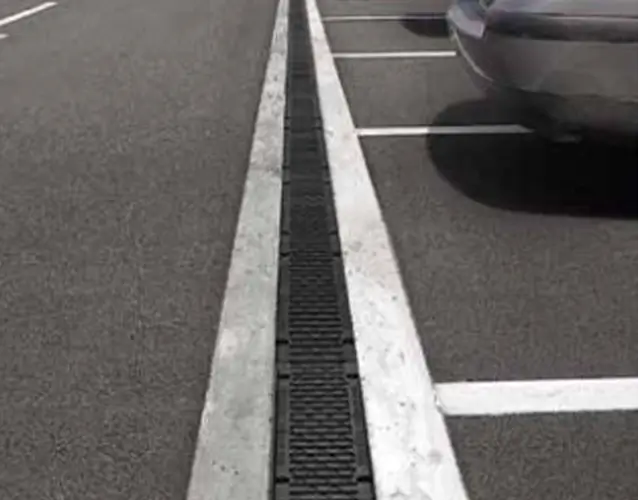
Road & Car Park Drainage Loading
For commercial and retail loading applications, the required drainage system must meet the higher demands of the environment while offering suitable drainage solutions. A combination of heavy foot traffic, medium vehicle traffic, and heavy equipment means that the installed channel drainage needs to be more robust. Channel drainage that can withstand up to 25 tonnes is usually recommended.
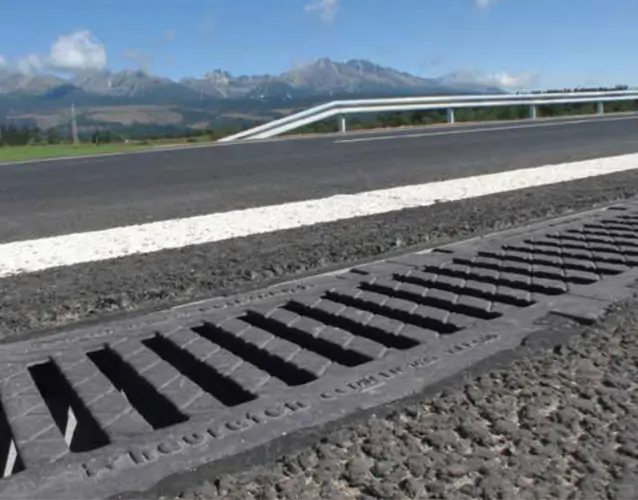
Highways & Traffic Area Drainage Loading
Highway drainage is pivotal in ensuring transport safety. Whether for a busy main road or heavily used car park, linear channel drain can be used to prevent localised flooding, which can otherwise cause accidents or delays. Susceptible to high-frequency, heavy vehicle traffic, the loading requirements for these applications are substantial. Channel drainage that can withstand up to 40 tonnes is usually recommended.
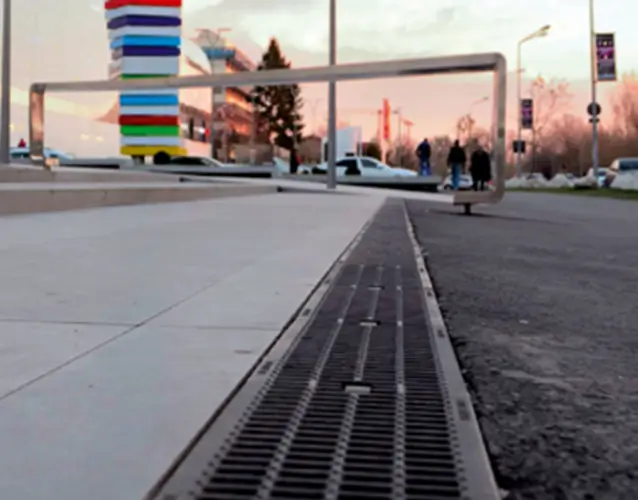
Public Safety Drainage Loading
The foremost objective of public safety is to prevent accidents, particularly in areas with heavy footfall. Public safety drainage loading refers to the load class requirements of drainage systems used to prevent the accumulation of water in public areas. These are areas that can also be subject to vehicle access for maintenance and upkeep, etc. This means that the loading requirements will be higher than most domestic applications. Channel drainage that can withstand up to 25 tonnes is usually recommended.
The loading requirements of medium-duty channel drain applications typically range between C250 and D400, depending on the specific application. Again, to ensure the proper drainage system is selected for your needs, you must evaluate the potential weight loads and the frequency of use in the area you want to install a linear channel drainage system. It isn’t just pedestrian and vehicle loads you need to consider, either. You may think that a supermarket should only need a B125 channel drainage, at most, because there is only pedestrian traffic to worry about. However, you would be ignoring the fact that there are often trollies, cages, or pallets full of heavy products that need to be moved around the retail area too. You have to try and predict the heaviest possible weight the channel drain might be exposed to in the desired area and base your loading choice on that. For any medium-duty applications, the general rule of thumb should be:
- Heavy foot traffic, medium vehicle or equipment traffic (maximum 25 tonnes and under) = C250 class channel drain will be needed as a minimum. This includes:
- Pavements, & pedestrian zones (with frequent vehicle access)
- Entrances
- Retail Areas
- Office Blocks
- Supermarkets
- Public Car Parks
- Healthcare Facilities
- Park & Ride Schemes
- Multi-Level & Basement Parking
- • Heavy and or/high-frequency vehicle traffic (maximum 40 tonnes and under) = D400 class channel drain is needed. This includes:
- Highways/Main roads
- Heavy vehicle parking
- Supermarket car parks
- Factories
For more about channel drainage use in car park applications, check out our separate article, “The best drainage channels for car parks”.
Industrial/Heavy-Duty Channel Drain Applications
The third type of loading application for linear channel drainage is Industrial or heavy-duty. This means that the system is designed to handle significant traffic loads, including extremely heavy vehicles, for industrial and commercial applications. These drains are commonly used in areas such as truck depots, airports, freight terminals, and industrial facilities. Heavy-duty systems are the most expensive and require professional installation, maintenance, and repair.
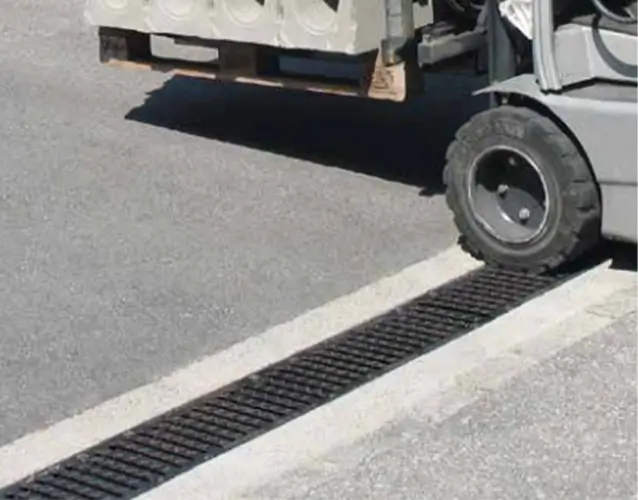
Industrial Drainage Loading
Industrial drainage channels are able to withstand loading applications up to 60 tonnes. They are designed for use in high-traffic, heavy-wheel-load areas, such as warehouses and distribution centres that use forklift trucks and delivery wagons, etc.
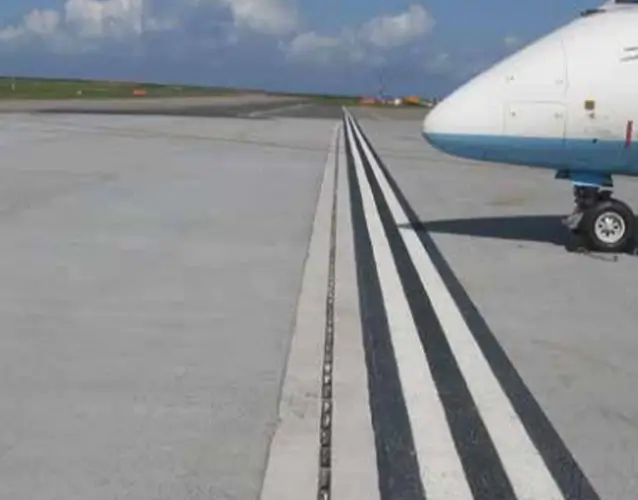
Heavy-Duty Drainage Loading
Heavy-duty drainage channels are the strongest available, with the ability to withstand weight-loading applications up to 90 tonnes. They are typically recommended for dock and airport drainage as they are designed for use in areas that impose heavy wheel loads or where extremely heavy vehicles can reach top speeds.
The loading requirements of heavy-duty channel drain applications typically range between E600 and F900, depending on the specific application. Again, to ensure the proper drainage system is selected for your needs, you must evaluate the potential weight loads and the frequency of use in the area you want to install a linear channel drainage system. For any heavy-duty applications, the general rule of thumb should be:
- High traffic, heavy wheel load industrial areas (maximum 60 tonnes and under) = E600 class channel drain will be required. This includes:
- Fire Stations
- Water Treatment Works
- Service Yards & Stock Yards
- Bio-Gas & Recycling Facilities
- Bus Terminals & Coach Parks
- Service Stations & Truck Stops
- Warehouses & Industrial Areas
- Logistics & Distribution Centres
For more about channel drainage use in these applications, check out our separate article, “Drainage for Docks, Warehouses and Distribution Centres”.
- Extremely heavy, high-intensity wheel loads (up to 90 tonnes) = F900 class channel drain is needed. This includes:
- Airports
- Military bases
- Oil & gas terminals
- Transport infrastructure
- Industrial area infrastructure
- Ports, docks and container terminals
For more about channel drainage use in car park applications, check out our separate article, “Heavy duty channel drainage explained”.
Specialised Applications
In addition to standard load-bearing applications, there are specialised situations that may require specific channel drain designs. For example, some areas may experience heavy forklift traffic or the need for chemical resistance. In these cases, heavy-duty channel drains with additional reinforcement, such as fibreglass-reinforced polymers (FRP), may be necessary. Additionally, certain industries, such as food processing or pharmaceuticals, may require channel drains with hygienic features to meet specific cleanliness standards.
If you have a channel drainage application with specific requirements, make sure you seek professional advice before making your decision, as material and grating type may play as big a part as the loading requirements.
We hope this has been an informative article, but do check out our “Basic Guide to Channel Drainage” and “Choosing the right channel drain for your project” articles for further information. If you are in the market for high-quality channel drainage, we stock a great range of channel drain products for all loading classes over in our Channel Drain section that we'd recommend taking a look at.
If you have any questions about channel drain loading classes or need any further advice about channel drainage in general, contact JDP today. Our team of experts are always on hand to help with all of your civils and drainage needs.


